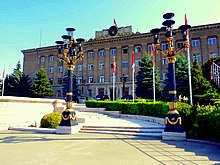Outline of the Republic of Artsakh
Overview of and topical guide to the Republic of Artsakh

The Flag of Artsakh


The following outline is provided as an overview and topical guide of the Republic of Artsakh and Nagorno-Karabakh region:
Nagorno-Karabakh is a disputed region in the South Caucasus region of Eurasia. It encompasses the former Republic of Artsakh, which was a de facto independent republic, and was de jure part of the Republic of Azerbaijan,[1] about 270 kilometers (170 mi) west of the Azerbaijani capital of Baku and neighbouring Armenia.[2]
General reference
- Pronunciation:
- Common English country name: Nagorno-Karabakh
- Official English country names: The Republic of Artsakh or (formerly and still commonly used, the Nagorno-Karabakh Republic)
- Common endonym(s):
- Official endonym(s):
- Adjectival(s):
- Demonym(s):
- Etymology: Name of Nagorno-Karabakh
- ISO country codes: See the Outline of Azerbaijan
- ISO region codes: See the Outline of Azerbaijan
- Internet country code top-level domain: See the Outline of Azerbaijan
Geography of Artsakh

- The Republic of Artsakh is: a de facto independent country, but it is officially part of the Republic of Azerbaijan[1]
- Location:
- Area of Artsakh: 4,400 km2
- Atlas of Nagorno-Karabakh
Regions of Artsakh

1: Martakert; 2: Askeran; 3: Stepanakert (city); 4: Martuni; 5: Shushi
Claimed regions:
6: Hadrut; 7: Shahumyan
(Areas shaded white indicate territory outside of the former Nagorno-Karabakh Autonomous Oblast and Shahumyan Region. Horizontal dashed lines indicate territory under the control of Azerbaijan.)
Administrative divisions of Artsakh

- Capital of the Republic of Artsakh: Stepanakert
- List of cities and towns in Artsakh
Demography of Artsakh
Government and politics of Artsakh
- Form of government: Unitary presidential republic
- Capital of Artsakh: Stepanakert
- Elections in Artsakh
Executive branch of the government of Artsakh

Legislative branch of the government of Artsakh

- National Assembly (unicameral)
Foreign relations of Artsakh
- Armenia-Artsakh relations
- List of representative offices of Artsakh
- Minister of Foreign Affairs
- Visa policy of Artsakh
- Visa requirements for Artsakh citizens
International organization membership
Law and order in Artsakh
Military of Artsakh
- Command
- Commander-in-chief:
- Ministry of Defence of Nagorno-Karabakh
- Commander-in-chief:
- Forces
- Artsakh Defense Army
- Air Force of Nagorno-Karabakh
- Special forces of Nagorno-Karabakh
- Military history of the Republic of Artsakh
- Military ranks of Nagorno-Karabakh
- Land mine situation in Nagorno-Karabakh
History of Artsakh
Culture of Artsakh

- Architecture of Nagorno-Karabakh
- Cuisine of Nagorno-Karabakh
- Coat of arms of Nagorno-Karabakh
- Flag of Nagorno-Karabakh
- Religion in Artsakh

Economy and infrastructure of Artsakh


See also
- Index of Artsakh-related articles
- List of international rankings
- List of Nagorno-Karabakh-related topics
- Outline of Armenia
- Outline of Europe
- Outline of Azerbaijan
- Outline of geography
References
- ^ a b "Azerbaijan". The World Factbook. United States Central Intelligence Agency. July 2, 2009. Retrieved July 23, 2009.
- ^ "Armenia". The World Factbook. United States Central Intelligence Agency. July 2, 2009. Retrieved July 23, 2009.
External links
 Wikimedia Atlas of Nagorno-Karabakh
Wikimedia Atlas of Nagorno-Karabakh
Non-partisan sources
- All UN Security Council resolutions on Nagorno-Karabakh, courtesy U.S. State department
- Article on the Dec. 10 Referendum from Russia Profile
- COE — "The conflict over the Nagorno-Karabakh region dealt with by the OSCE Minsk Conference" Report by rapporteur David Atkinson presented to Political Affairs Committee of the Parliamentary Assembly of the Council of Europe
- Conciliation Resources - Accord issue: The limits of leadership - Elites and societies in the Nagorny Karabakh peace process also key texts & agreements and chronology (in English & Russian)
- Independence of Kosovo and the Nagorno-Karabakh Issue
- Interview with Thomas De Waal
- Radio Free Europe / Radio Liberty. Nagorno-Karabakh: Timeline Of The Long Road To Peace
- Regions and territories: Nagorno-Karabakh from the BBC
- Resolution #1416 from the Parliamentary Assembly of the Council of Europe
- USIP — Nagorno-Karabakh Searching for a Solution: Key points, by Patricia Carley, Publication of the United States Institute of Peace (USIP)
- USIP — Sovereignty after Empire Self-Determination Movements in the Former Soviet Union. Case Studies: Nagorno-Karabakh. by Galina Starovoitova, Publication of the United States Institute of Peace (USIP)
Armenian perspective
- "Azat Artsakh" Daily Newspaper in Nagorno-Karabakh
- NKR Office in Washington, DC
- Official site of the Nagorno-Karabakh government
- Official site of the Nagorno-Karabakh Republic Ministry of Foreign Affairs
Azerbaijani perspective
- Artsakh.com
- Ministry of Foreign Affairs of Azerbaijan republic
- Karabakh.co.uk Archived 2007-10-30 at the Wayback Machine
- Karabakh.org
- v
- t
- e
Wikipedia outlines
General reference
- Culture and the arts
- Geography and places
- Health and fitness
- History and events
- Mathematics and logic
- Natural and physical sciences
- People and self
- Philosophy and thinking
- Religion and belief systems
- Society and social sciences
- Technology and applied sciences















